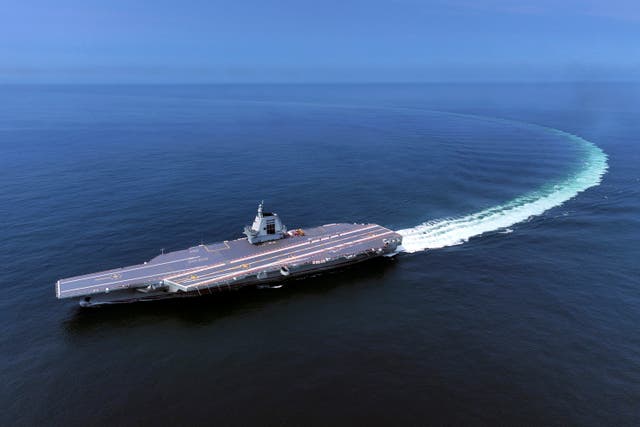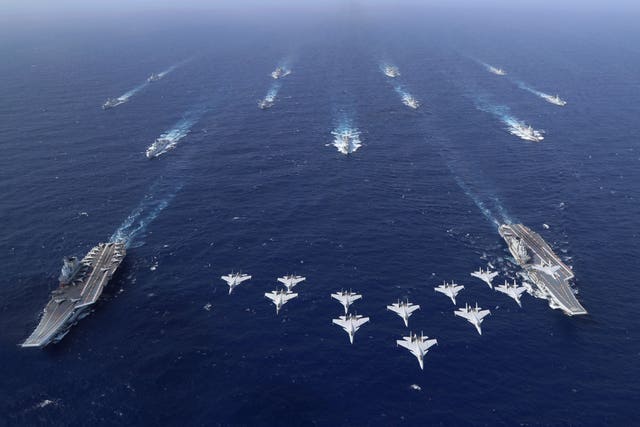
China has built a land-based prototype nuclear reactor for a large surface warship, in the clearest sign yet that Beijing is advancing towards producing its first nuclear-powered aircraft carrier.
That is according to new analysis of satellite imagery and Chinese government documents provided to The Associated Press.
China’s navy is already the world’s largest numerically, and it has been rapidly modernising. Adding nuclear-powered carriers to its fleet would be a major step in realising its ambitions for a true “blue-water” force capable of operating in seas far from China in a growing global challenge to the United States.
“Nuclear-powered carriers would place China in the exclusive ranks of first-class naval powers, a group currently limited to the United States and France,” said Tong Zhao, a senior fellow at the Carnegie Endowment for International Peace in Washington DC.
“For China’s leadership, such a development would symbolise national prestige, fueling domestic nationalism and elevating the country’s global image as a leading power.”

Researchers at the Middlebury Institute of International Studies in California said they made the finding while investigating a mountain site outside the city of Leshan in the southwest Chinese province of Sichuan, where they suspected China was building a reactor to produce plutonium or tritium for weapons.
Instead, they concluded that China was building a prototype reactor for a large warship.
The project at Leshan is dubbed the Longwei, or Dragon Might, Project and is also referred to as the Nuclear Power Development Project in documents.
Neither China’s Defence Ministry nor Foreign Affairs Ministry responded to requests for comment.
There have long been rumours that China is planning to build a nuclear-powered aircraft carrier, but the research by the Middlebury team is the first to confirm that China is working on a nuclear-powered propulsion system for a carrier-sized surface warship.
“The reactor prototype at Leshan is the first solid evidence that China is, in fact, developing a nuclear-powered aircraft carrier,” said Jeffrey Lewis, a professor at Middlebury and one of the researchers on the project.
“Operating a nuclear-powered aircraft carrier is an exclusive club, one that China looks set to join.”
Drawing on satellite images and public documents including project tenders, personnel files, environmental impact studies — and even a citizen’s complaint about noisy construction and excessive dust — they concluded a prototype reactor for naval propulsion was being built in the mountains of Mucheng township, some 70 miles southwest of Sichuan’s provincial capital Chengdu.
The reactor, which procurement documents indicate will soon be operational, is housed in a new facility built at the site known as Base 909, which houses six other reactors that are operational, decommissioned or under construction, according to the analysis.
The site is under the control of the Nuclear Power Institute of China, a subsidiary of the China National Nuclear Corporation, which is tasked with reactor engineering research and testing.
Documents indicate that China’s 701 Institute, formally known as China Ship Research and Design Center, which is responsible for aircraft carrier development, procured reactor equipment “intended for installation on a large surface warship” under the Nuclear Power Development Project as well as the project’s “national defence designation” helped lead to the conclusion the sizable reactor is a prototype for a next-generation aircraft carrier.
Satellite images from 2020 to 2023 have shown the demolition of homes and the construction of water intake infrastructure connected to the reactor site.
Contracts for steam generators and turbine pumps indicate the project involves a pressurised water reactor with a secondary circuit — a profile that is consistent with naval propulsion reactors, the researchers say.
An environmental impact report calls the Longwei Project a “national defence-related construction project” that is classified as “secret”.
“Unless China is developing nuclear-powered cruisers, which were pursued only by the United States and the Soviet Union during the Cold War, then the Nuclear Power Development Project most certainly refers to a nuclear-powered aircraft carrier development effort,” researchers wrote in a detailed 19-page report on their findings.
Sarah Laderman, a senior analyst with Open Nuclear Network, a program of the US-based NGO PAX sapiens Foundation, said the findings were “carefully conducted and thoroughly researched”.
“Given the evidence presented here, I see a compelling case made that China seems to be working towards building a nuclear propulsion system for its naval surface ships (likely aircraft carriers) at this location,” said Ms Laderman, who is based in Vienna and was not involved in Middlebury’s research.
The US is obligated by domestic law to supply Taiwan with sufficient weapons to deter invasion, and it could provide assistance to the island from its bases in the Pacific in the event of an invasion or blockade.
Tensions also have risen in the South China Sea between China and neighbouring nations over territorial disputes and maritime claims.

Chinese President Xi Jinping has tasked defence officials with building a “first-class” navy and becoming a maritime power as part of his blueprint for the country’s rejuvenation.
The country’s most recent white paper on national defence, dated 2019, said the Chinese navy was adjusting to strategic requirements by “speeding up the transition of its tasks from defence on the near seas to protection missions on the far seas”.
The People’s Liberation Army Navy is already the world’s largest navy with more than 370 ships and submarines. The country also boasts powerful shipbuilding capabilities: China’s shipyards are building many hundreds of vessels each year, whereas the US is building five or fewer, according to a US congressional report late last year.
However, the Chinese navy lags behind the US Navy in many respects. Among other advantages, the US currently has 11 carriers, all nuclear-powered, allowing it to keep multiple strike groups deployed around the world at all times, including in the Indo-Pacific.
But the Pentagon is growing increasingly concerned about China’s rapid modernisation of its fleet, including the design and construction of new carriers.
That aligns with China’s “growing emphasis on the maritime domain and increasing demands” for its navy “to operate at greater distances from mainland China,” the Defence Department said in its most recent report to US Congress on China’s military.
China’s “growing force of aircraft carriers extend air defence coverage of deployed task groups beyond the range of land-based defences, enabling operations farther from China’s shore,” the report said.


Why are you making commenting on The Herald only available to subscribers?
It should have been a safe space for informed debate, somewhere for readers to discuss issues around the biggest stories of the day, but all too often the below the line comments on most websites have become bogged down by off-topic discussions and abuse.
heraldscotland.com is tackling this problem by allowing only subscribers to comment.
We are doing this to improve the experience for our loyal readers and we believe it will reduce the ability of trolls and troublemakers, who occasionally find their way onto our site, to abuse our journalists and readers. We also hope it will help the comments section fulfil its promise as a part of Scotland's conversation with itself.
We are lucky at The Herald. We are read by an informed, educated readership who can add their knowledge and insights to our stories.
That is invaluable.
We are making the subscriber-only change to support our valued readers, who tell us they don't want the site cluttered up with irrelevant comments, untruths and abuse.
In the past, the journalist’s job was to collect and distribute information to the audience. Technology means that readers can shape a discussion. We look forward to hearing from you on heraldscotland.com
Comments & Moderation
Readers’ comments: You are personally liable for the content of any comments you upload to this website, so please act responsibly. We do not pre-moderate or monitor readers’ comments appearing on our websites, but we do post-moderate in response to complaints we receive or otherwise when a potential problem comes to our attention. You can make a complaint by using the ‘report this post’ link . We may then apply our discretion under the user terms to amend or delete comments.
Post moderation is undertaken full-time 9am-6pm on weekdays, and on a part-time basis outwith those hours.
Read the rules here